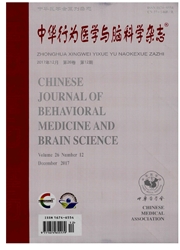

 中文摘要:
中文摘要:
目的探讨强迫症患者的冲动功能与正常人群之间的差异。方法选取符合DSM—IV诊断标准的71例强迫症患者及65例健康对照,采用Barratt冲动性量表(BIS-11),耶鲁-布朗强迫症状量表(Y-BOCS)分别于治疗前和治疗后16周评估其冲动性及症状严重程度。结果治疗前,强迫症组的注意冲动[14(12,16)分]、无计划冲动得分[26(23,28)分]均高于对照组[12(11,13)分][23(20.5,26)分],差异有统计学意义(P〈0.01)。治疗后,注意冲动与Y—BOCS评分的减分率呈正相关(r=0.443,P=0.018);Logistic回归分析显示,冲动总分较高,强迫症患者的治疗疗效较好(β=-0.149,P=0.002)。结论强迫症患者存在注意和无计划冲动功能的损害。随着强迫症状改善,其注意冲动功能也有所恢复。治疗前BIS-11总分较高的患者疗效较好。
 英文摘要:
英文摘要:
Objective To investigate the difference of impulsiveness between patients of obsessive- compulsive disorder(OCD) and healthy controls. Methods Seventy-one patients who met the DSM-IV cri- teria for OCD ,and sixty-five healthy controls were recruited.Impulsiveness and the severity of symptom were assessed with Barratt Impulsivity Scale( BIS-11 ) and Yale-Brown Obsessive Compulsive Scale(Y-BOCS) hefore and the end of 16th week treatment. Results Before treatment,attentional impulsivity scores( 14( 12, 16 ) ) and non-planning impulsivity scores ( 26 ( 23,28 ) ) were significantly higher ( all P〈 0.01 ) in OCD patients compared with controls ( 12 ( 11,13), 23 (20.5,26) ). After treament, the reduction rate of attentional impulsivity was positively correlated with the reduction rate of Y-BOCS ( r= 0.443, P= 0.018 ). Logistic regression analysis reported that with the total scores of BIS-11 increased, the effect of treatment was improved (β=-0.149, P=0.002). Conclusion Increased attentional and non-planning impulsivity are found in OCD. As the improvement of symptom, the scores of attentional impulsivity are also decreased. The high total scores of BIS-11 are correlated with the efficacy of treatment.
 同期刊论文项目
同期刊论文项目
 同项目期刊论文
同项目期刊论文
 期刊信息
期刊信息
